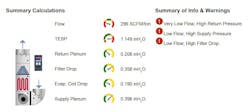Renovating a duct system can be overwhelming for you and your customers. When you recommend replacing or renovating residential duct work, it is usually because you have low total system airflow and high static pressures. It’s at this point when you realize there is nothing else you can do to improve your customers’ airflow issues besides making major changes to their duct system. What if I told you there might be an easier way?
The day I started doing Manual J load calculations, my whole world changed. This is when I started working smarter and not harder.
I have spent most of my career working in large, fancy homes in the Chicagoland area. Like the rest of the country, we have major issues with low total system airflow and high static pressure. Years ago, I started increasing the surface area of the air filters that I installed. I also took extra time, and hand selected an evaporator coil, making sure to have a correct AHRI match up at the lowest pressure drop possible. Sometimes I would run an extra return duct off the drop, but when doing so I paid close attention to the room pressures. If you have gone through National Comfort Institute (NCI) training, this should sound familiar to you. What I described is the definition of an AIR UPGRADE.
Sometimes You Need More
While this approach to decrease static pressure and increase total system airflow is useful and works in most situations, there are times when it isn’t enough. In this situation I usually have a conversation with the customer about renovating or replacing their existing duct system. The problem is that more times than not the duct system in the basement was enclosed in a drywall ceiling. It is difficult to replace duct work that is covered by drywall and even more difficult to convince your customer to remove the drywall. Let’s face it, these types of calls don’t present themselves in the shoulder season when we are slow. They usually pop up in the middle of the summer when your phone is ringing off the hook.
Most of the time when you get to this point, the customer is probably considering equipment replacement. In the past, I would replace like for like equipment, meaning if they had a 100,000 BTU furnace and a 3.5-ton condenser, that was the size of new equipment that I would install. The day I started doing Manual J load calculations, my whole world changed. This is when I started working smarter and not harder.
Go After the Low Hanging Fruit
How can you fix a duct system without touching tin snips, duct sealer, or foil tape? Start by installing correctly sized equipment for the home. I noticed that on 90% of my jobs, I made drastic reductions in equipment sizing. In the beginning, reducing equipment size was terrifying. I was so nervous that a customer would call me during a polar vortex complaining that their toilet bowl had frozen over. Right-sizing equipment eventually became less scary as time went on because the heat always kept up. Manual J works and it works well.
If you can legitimately install smaller HVAC equipment on an existing duct system, you are effectively reducing your airflow requirements. If you reduce the airflow through a duct system you are also reducing the static pressure and pressure drops at the square of airflow.
We dive into how this math works in NCI’s Duct System Optimization course where we cover Fan Law 2: If airflow increases, static pressure will increase more. If airflow decreases, static pressure will decrease more. In other words, changes in airflow have a larger dynamic impact on static pressure.
Like for Like is Not Right (Sized)
We all know that most residential duct work is undersized. Things start to become so much easier when you understand that HVAC equipment is usually oversized. If you install properly sized equipment on a duct system that was originally undersized, by reducing the equipment’s airflow requirement, that same duct system works just fine. When you reduce the duct pressures you are also reducing the duct leakage. This means a higher percentage of airflow is making it to the rooms that need it.
Performing a load calculation can be overwhelming. I think most contractors want to do the right thing but don’t have the time to learn a new process or new software. If we look at the tonnage of most condensers and compare it to the size of the home, you will find that most systems are sized from 400 to 600 square feet per ton. This rule of thumb is used because it is easy.
Advancements in Technology
Manual J software has come a long way in the past few years and is now much easier to use. Conduit Tech is an app for the Apple iPad pro which uses lidar to measure all the surface areas of the home. Conduit makes it easy to perform a load calc in just a few minutes.
If you are looking for a program that can perform a Manual D duct design, my favorite Windows-based software is Kwik Model with Energy Gauge Loads. This software allows you to model the home in 3D with a complete duct system, which helps to visualize how big the ducts are, and the best place to install them. Like anything else, every software has a learning curve. But learning residential HVAC design allows you to start working smarter and not harder.
Considering proper sizing methods will help you to use existing duct systems without costly duct renovations. This will allow you to install equipment that will work the way it was designed.
Adam Mufich serves the HVAC industry as content developer and instructor for National Comfort Institute, Inc. (NCI). NCI specializes in training that focuses on improving, measuring, and verifying HVAC and Building Performance.
If you’re an HVAC contractor or technician interested in learning more about air sealing benefits, contact Adam at ncilink.com/ContactMe. NCI’s website www.nationalcomfortinstitute.com is full of free information to help you improve your professionalism and strengthen your company.
About the Author
Adam Mufich
content developer and instructor
Adam Mufich serves the HVAC industry as content developer and instructor for National Comfort Institute, Inc. (NCI). NCI specializes in training that focuses on improving, measuring, and verifying HVAC and Building Performance. Find them at www.nationalcomfortinstitute.com.


